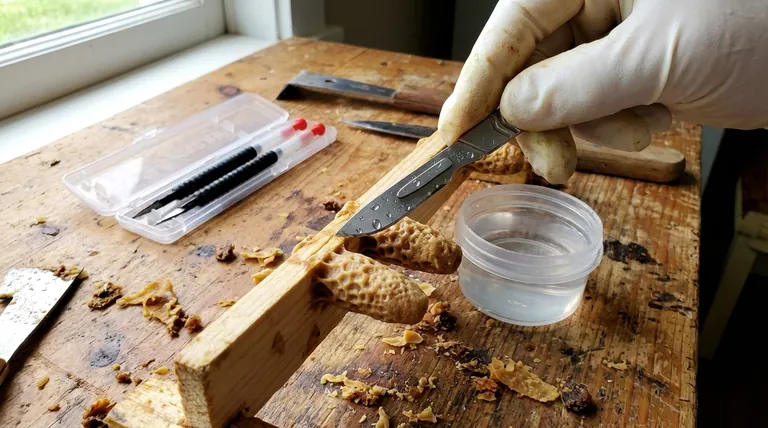To separate adjoining cells on a cell bar, a very sharp, wet knife is used to make a clean, single cut between them. This technique is critical in queen bee rearing to isolate individual queen cells from the bar without damaging their delicate wax structure or harming the developing queen pupa inside.
The core principle is not simply to separate the cells, but to do so with surgical precision. Using a sharp, wet blade prevents the beeswax from tearing or sticking, ensuring the viability of each individual queen cell for introduction into a new colony.

Understanding the Context: The Queen Rearing Process
Queen cells, which house developing queen bees, are incredibly fragile structures. They are attached to a "cell bar," a removable frame component used by beekeepers to raise multiple queens at once.
The Anatomy of a Queen Cell
A mature queen cell consists of a base, which is firmly attached to the cell bar, and a long, peanut-shaped cell hanging downward. The walls are made of beeswax and are easily crushed, torn, or deformed.
Inside this delicate structure, a queen pupa is undergoing its final stages of metamorphosis. Any physical shock or damage to the cell can injure or kill her.
Why Separation is Necessary
Beekeepers raise queens on a single bar for efficiency. Once the cells are "ripe" (capped and nearing the emergence date), they must be separated so each one can be carefully introduced into a different queenless colony or a small mating nucleus hive.
The Technique: Precision is Paramount
The goal is to slice cleanly through the wax that connects two adjacent cells. This requires the right tool and a steady hand.
Why 'Sharp' is Non-Negotiable
A sharp knife, such as a scalpel, grafting tool, or a razor blade, is essential. A dull blade will not slice the wax; it will crush and tear it.
This tearing action can rip the side of the cell wall, exposing or injuring the pupa. A crushed cell is a dead queen. The cut must be clean and effortless.
Why 'Wet' is Critical
Beeswax is naturally sticky, especially at the temperatures found inside a hive. A dry knife blade will drag and pull on the wax as it cuts.
Dipping the blade in clean, cool water just before each cut lubricates it. This allows the knife to glide through the wax without sticking, preventing any pulling or tearing motion that could damage the cell.
Understanding the Risks and Common Pitfalls
Executing this task improperly is a common point of failure for novice queen rearers. Understanding the risks helps you avoid them.
The Mistake of Using the Wrong Tool
Using a thick, dull, or serrated knife is the most common mistake. This will mangle the wax, compress the cells, and almost certainly result in failed queens. Always choose a tool designed for precision.
The Danger of a Sawing Motion
Do not "saw" back and forth to get through the wax. This increases the chance of tearing and introduces unnecessary vibration. The cut should be a single, decisive downward press.
Mishandling After the Cut
Once separated, handle the queen cell only by its thick plastic or wax base. Never squeeze the sides of the cell itself, as this can fatally injure the queen inside.
Making the Right Choice for Your Goal
Your approach to this task directly impacts the success rate of your queen rearing efforts.
- If your primary focus is maximizing the number of viable queens: Prioritize using a surgically sharp, wet blade and a slow, deliberate technique above all else.
- If you are new to the process: Practice on a bar with empty queen cups or old comb to understand how the wax responds to the blade before you work on live, valuable cells.
Mastering this simple but critical step is a fundamental skill for successful and reliable queen production.
Summary Table:
| Key Factor | Purpose | Why It's Critical |
|---|---|---|
| Sharp Knife | To make a clean, single cut | Prevents crushing and tearing the delicate wax cell walls. |
| Wet Blade | To lubricate the cut | Allows the blade to glide without sticking, avoiding damage to the queen pupa. |
| Single, Decisive Cut | To separate cells cleanly | Minimizes vibration and physical shock, protecting the developing queen. |
Ready to elevate your queen rearing operation? HONESTBEE supplies commercial apiaries and beekeeping equipment distributors with the high-quality, precision tools essential for success. From durable grafting knives to reliable cell bars, our wholesale-focused operations ensure you have the right equipment to protect your valuable queens. Contact HONESTBEE today to discuss your needs and secure the best supplies for your business.
Visual Guide

Related Products
- Black 2 Pack Beekeeper Queen Grafting Tool for Bee Queen Larva Transferring Needle
- Plastic Chinese Queen Grafting Tool for Bee Queen Rearing
- Double Head Beekeeping Grafting Tools for Beekeepers
- Brown Nicot Queen Cell Cups for Breeding Queen Bees Beekeeping
- JZBZ Push-In Queen Cell Cups for Beekeeping
People Also Ask
- What is the purpose of a queen grafting tool in beekeeping? Master Larva Transfer for Selective Breeding
- What is the purpose of grafting in queen bee production? Scale Your Apiary with Superior Genetics
- What are the steps involved in using a queen grafting tool? A Guide to Successful Queen Rearing
- What tools are used to transfer larvae into queen cell cups? A Guide to Grafting Tools for Queen Rearing
- What happens if a larva is grafted too late? Avoid Scrub Queens and Failed Rearing



















